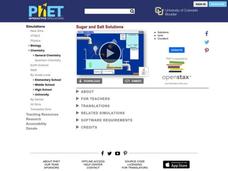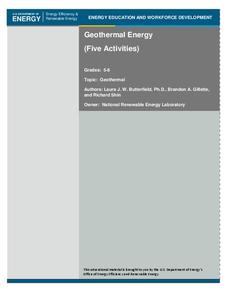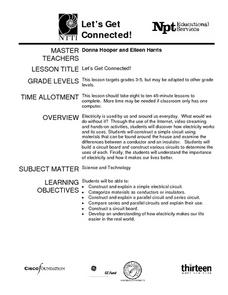Consumers Energy
Conductors and Insulators
Why did the orchestra director use a copper baton? She heard it makes a great conductor. Scholars select six items to test in a circuit to determine if each is a conductor or an insulator. Clear instructions for using electricity allow...
PhET
Sugar and Salt Solutions
Ionic bonds form from electrostatic energy, allowing for higher conductivity than those seen in covalent bonds. In the simulation, learners add sugar and salt to water and see the effects on concentration and conductivity of their...
Virginia Department of Education
Physical and Chemical Properties of Water
How can you effectively provide detailed concepts of water properties to your high school class in a way they find exciting and challenging at the same time? By letting them play, of course! Through a variety of experiments, pupils...
Virginia Department of Education
Metals, Nonmetals, and Metalloids
How can one easily classify metals, nonmetals, and metalloids? Pupils answer this question as they experiment with unknown substances and perform tests on conductivity, brittleness, and malleability to determine which unknown belongs in...
American Chemical Society
Matter on the Move
Start this mini unit on matter out by demonstrating how food coloring behaves when placed in cold and in hot water. Then have the class experiment with warm water and soap film. Pupils will learn that an increase in thermal energy also...
Institute of Electrical and Electronics Engineers
The Power of Graphene
To prepare for the activity, STEM classes read about nanotechnology and the amazing properties of graphene. They collect a graphene sample from pencils, and then connect them into simple circuits to determine whether it makes a better...
Scholastic
Study Jams! Heat
Raise the temperature in your class with this hot film! Cartoon teens discuss thermal energy, the conservation and transfer of energy, three methods of heat transfer, conductors, and insulators. The publisher effectively packed every...
US Department of Energy
Geothermal Energy
With Earth Day quickly approaching, as well as many science fairs, why not challenge your class to investigate geothermal energy or other renewable energy resources? There are five driving questions explored in depth here, as well as...
Curated OER
Charge and Electricity
In this charge and electricity instructional activity, students read about electric charges and how they are created in atoms. They also read about the unit of charge, called the Coulomb, conductors, and insulators. Emerging electricians...
Curated OER
Heat and the Second Law of Thermodynamics
More than a week's worth of investigation is provided in this source. Physical science stars experiment to describe specific heat, conduction, convection, and radiation. They also discover the relationship between mechanical and thermal...
Curated OER
Magnetic Induction
Physicists of the future observe the behavior of current in relation to a magnet through several inquiry activities. They construct a generator and experiment with solenoid coils. They learn and apply electromagnetic laws, most often...
Curated OER
Fall 2005 Midterm Exam #1
You've got the power! With this physics midterm, you have the power to assess learners' grasp of electricity concepts. The exam is neatly formatted and provides a variety of question types: true or false, multiple choice, and problem...
Curated OER
Fall 2003 Midterm Exam #1
Electricity is the focus of this college-level midterm exam. It requres physics learners to answer multiple choice and short answer questions in addition to evaluating several diagrams and graphs. This is appropriate for most high school...
Curated OER
Let's Get Connected!
A great lesson introduces your youngsters to electricity. They use internet links, streaming video, and engage in hands-on activities to understand what electricity is and how it works. They build a circuit board, and construct a variety...
Curated OER
Heat Transfer Demos
Step-by-step instructions are given for two hands-on activities. Young scientists cut out a paper spiral and hold it over a hot plate to demonstrate convection, and they place a small piece of wax on the end of a metal rod opposite the...
Curated OER
How Hot Is It?
Discuss the difference between conduction, convection and radiation of thermal energy, and complete activities with your class by investigating the difference between temperature, thermal energy and the heat capacity of different materials.
Curated OER
Electric Circuits
Experiment with electric circuits and conductivity. Young scientists will model and discuss how an electric circuit works. First they will draw a model of the flow of electrons and then build an actual circuit. Finally, they will explain...
Curated OER
Applications of Energy to the Real World
As an introduction to the concept of energy, this interesting and informative resource would be a terrific addition to a unit. Although there is quite a bit of information presented about kinetic energy, potential energy, and related...
Museum of Science
City Circuit
Here's an electric lesson on electricity. Pupils create an electric circuit to model a city's electric system. They then test out different materials to see whether they are conductors of electricity.
Science Matters
Series Circuit and Switches
Lights out! Scholars build on their understanding of a simple circuit by adding a switch and creating schematic drawings. The eighth activity in a series of 14 has pupils use everyday materials to create circuits and make observations as...
Purdue University
Light – Just Right!
What does it mean to be resistant to electricity? Scholars answer the question in a six-part STEM activity on electricity. They begin by assessing the conductivity of several different materials and progress to designing their own...
Discovery Education
It's Melting!
It's a race to the finish! Which ice cube will melt the fastest? Scholars discover the effect thermal energy has on melting ice. They experiment with melting ice cubes on different materials and learn that even at a consistent...
Discovery Education
Cool It!
Adjust the melting time of ice without varying the temperature! Learners experiment with different materials to decide how the materials affect the rate an ice cube melts. They then connect their findings to the conductivity of each...
College Board
2017 AP® Physics 2: Algebra-Based Free-Response Questions
In 2017, more than 15,000 scholars earned college credit based on their AP Physics 2 exam covering lenses, energy, and more. The College Board released the free-response questions, sample answers, and scoring guidelines from that exact...

























